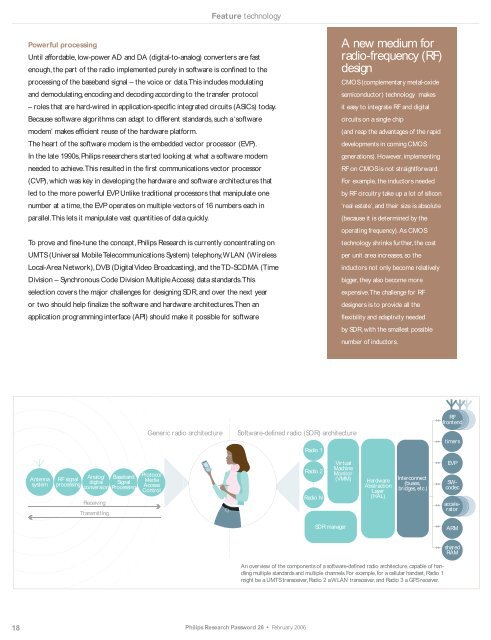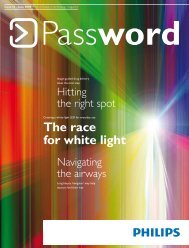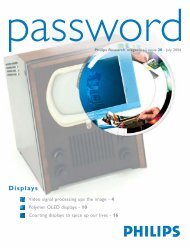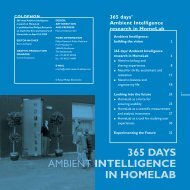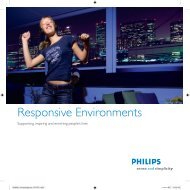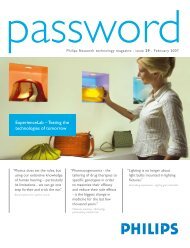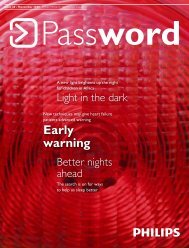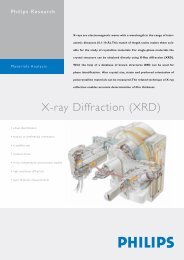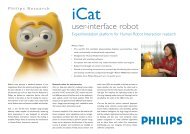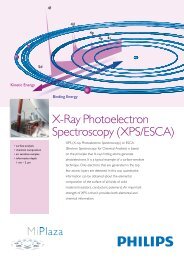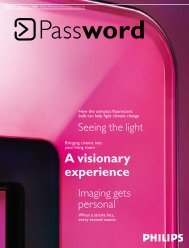article - Philips Research
article - Philips Research
article - Philips Research
Create successful ePaper yourself
Turn your PDF publications into a flip-book with our unique Google optimized e-Paper software.
Powerful processing<br />
Until affordable, low-power AD and DA (digital-to-analog) converters are fast<br />
enough, the part of the radio implemented purely in software is confi ned to the<br />
processing of the baseband signal – the voice or data. This includes modulating<br />
and demodulating, encoding and decoding according to the transfer protocol<br />
– roles that are hard-wired in application-specifi c integrated circuits (ASICs) today.<br />
Because software algorithms can adapt to different standards, such a ‘software<br />
modem’ makes effi cient reuse of the hardware platform.<br />
The heart of the software modem is the embedded vector processor (EVP).<br />
In the late 1990s, <strong>Philips</strong> researchers started looking at what a software modem<br />
needed to achieve. This resulted in the fi rst communications vector processor<br />
(CVP), which was key in developing the hardware and software architectures that<br />
led to the more powerful EVP. Unlike traditional processors that manipulate one<br />
number at a time, the EVP operates on multiple vectors of 16 numbers each in<br />
parallel. This lets it manipulate vast quantities of data quickly.<br />
To prove and fi ne-tune the concept, <strong>Philips</strong> <strong>Research</strong> is currently concentrating on<br />
UMTS (Universal Mobile Telecommunications System) telephony, WLAN (Wireless<br />
Local-Area Network), DVB (Digital Video Broadcasting), and the TD-SCDMA (Time<br />
Division – Synchronous Code Division Multiple Access) data standards. This<br />
selection covers the major challenges for designing SDR, and over the next year<br />
or two should help fi nalize the software and hardware architectures. Then an<br />
application programming interface (API) should make it possible for software<br />
Antenna<br />
system<br />
RF signal<br />
processing<br />
Analog/<br />
digital<br />
conversion<br />
Receiving<br />
Transmitting<br />
Baseband<br />
Signal<br />
Processing<br />
Feature technology Feature technology<br />
Generic radio architecture Software-defined radio (SDR) architecture<br />
Protocol<br />
Media<br />
Access<br />
Control<br />
Radio 1<br />
Radio 2<br />
Radio N<br />
A new medium for<br />
radio-frequency (RF)<br />
design<br />
CMOS (complementary metal-oxide<br />
semiconductor) technology makes<br />
it easy to integrate RF and digital<br />
circuits on a single chip<br />
(and reap the advantages of the rapid<br />
developments in coming CMOS<br />
generations). However, implementing<br />
RF on CMOS is not straightforward.<br />
For example, the inductors needed<br />
by RF circuitry take up a lot of silicon<br />
‘real estate’, and their size is absolute<br />
(because it is determined by the<br />
operating frequency). As CMOS<br />
technology shrinks further, the cost<br />
per unit area increases, so the<br />
inductors not only become relatively<br />
bigger, they also become more<br />
expensive. The challenge for RF<br />
designers is to provide all the<br />
fl exibility and adaptivity needed<br />
by SDR, with the smallest possible<br />
number of inductors.<br />
Virtual<br />
Machine<br />
Monitor<br />
(VMM)<br />
SDR manager<br />
Hardware<br />
Abstraction<br />
Layer<br />
(HAL)<br />
Interconnect<br />
(buses,<br />
bridges, etc.)<br />
An overview of the components of a software-defi ned radio architecture, capable of handling<br />
multiple standards and multiple channels. For example, for a cellular handset, Radio 1<br />
might be a UMTS transceiver, Radio 2 a WLAN transceiver, and Radio 3 a GPS receiver.<br />
RF<br />
frontend<br />
timers<br />
EVP<br />
SWcodec<br />
accelerator<br />
ARM<br />
shared<br />
RAM<br />
suppliers to set up other radio standards.<br />
Running different radios simultaneously on the same, generic hardware is the<br />
ultimate goal of the current research. This minimizes the hardware cost and the<br />
power consumption of the overall device, but it means ‘virtualizing’ the radios so<br />
they can run independently. Virtualization has been around since the 1960s, but<br />
SDR needs to allocate the shared hardware and processing blocks used to emulate<br />
the radio, from the antenna to the user, while isolating the various incoming and<br />
outgoing signals from one another. Encapsulating the radio pipes and switching<br />
between them every few microseconds has to guarantee uninterrupted real-time<br />
performance – not a trivial matter.<br />
Industry implications<br />
SDR will roll out slowly, taking over slowly from existing technology as this reaches<br />
technical and economic obsolescence. The fi rst generation of SDR mobile phone<br />
products is expected around 2008. Using a minimum set of parallel, softwarecontrolled<br />
bi- and tri-standard RF blocks with a single processor block, these<br />
should be able to cover standards from cellular telephony to networking to radio<br />
and TV. Signifi cantly, they should be able to do this at close to the same cost as<br />
today’s devices.<br />
A major goal of SDR is to serve many markets, many customers, and many<br />
standards with a minimum number of architectures and chips. This will not only<br />
reduce R&D costs, but also greatly simplify logistics for both the semiconductor<br />
manufacturers and handset makers. But it is a big step. So big that no party can go<br />
it alone. The established companies are already talking together about open designs<br />
that should ease programming specialized applications. Apart from <strong>Philips</strong>, other<br />
major players include Infi neon, Samsung, Benq and Nokia. For handset<br />
manufacturers in particular, the greater fl exibility will shorten development cycles<br />
and make it easy to patch performance or upgrade algorithms, and through this<br />
reinforce the positive value of their brand. For operators, SDR makes it easier to<br />
provide new, fashionable and above all competitive services. Reconfi gurable<br />
handsets also have longer useful lifetimes – an important consideration in Europe<br />
where operators subsidize most handsets. Open, industry-standards for<br />
SDR APIs (application program interfaces) could open up a whole new market for<br />
radio software.<br />
By reducing development effort and component costs and by improving fl exibility,<br />
responsiveness and ease of product diversifi cation, SDR should benefi t everybody,<br />
not least the end-user. Even before it fi nds applications in other, and yet<br />
unthought-of areas, SDR will be a key technology in how we communicate<br />
in the future.<br />
Dr Neil Bird l <strong>Philips</strong> <strong>Research</strong> l neil.bird@philips.com<br />
Prof dr ir Kees van Berkel l <strong>Philips</strong> <strong>Research</strong> l kees.van.berkel@philips.com<br />
Dr ir Albert van der Werf l <strong>Philips</strong> <strong>Research</strong> l albert.van.der.werf@philips.com<br />
Extra info www.research.philips.com/password l software-defi ned radio l RF IC design<br />
<strong>Philips</strong>’ unique<br />
position<br />
<strong>Philips</strong>’ expertise in the various areas<br />
touched by SDR places the company<br />
in a uniquely favorable position for<br />
developing the fi rst generation of SDR<br />
equipment. <strong>Philips</strong> <strong>Research</strong> has already<br />
designed and simulated an antenna<br />
for use over fi ve cellular bands, and<br />
demonstrated a multimode receiver for<br />
GSM, UMTS and CDMA2000 standards.<br />
The DSP Innovation Centre (<strong>Philips</strong><br />
Semiconductors) has developed an EVP<br />
capable of 100 parallel operations at<br />
speeds of 300 MHz. Also, <strong>Philips</strong><br />
Semiconductors have already developed<br />
and productized a multi-standard<br />
baseband chip for WLAN and DVB-H,<br />
based on the predecessor of the EVP.<br />
This established position on both sides<br />
of the RF divide places <strong>Philips</strong> ideally to<br />
make the most of SDR.<br />
<strong>Research</strong>ers are working closely with<br />
<strong>Philips</strong> Semiconductors to make sure<br />
their designs are not just functional, but<br />
also feasible, and, of course, attractive<br />
for <strong>Philips</strong> customers of both complete<br />
radios and chipsets for further software<br />
development.<br />
18 <strong>Philips</strong> <strong>Research</strong> Password 26 l February 2006 <strong>Philips</strong> <strong>Research</strong> Password 26 19<br />
l February 2006


